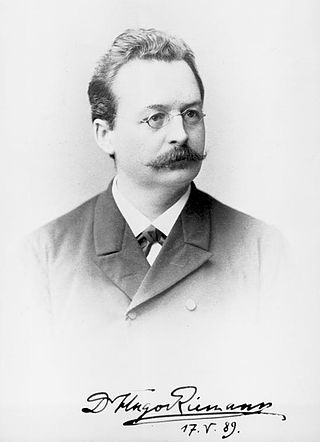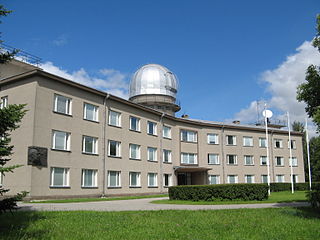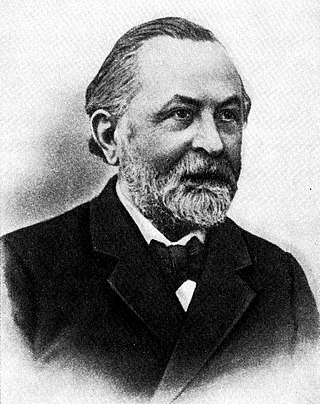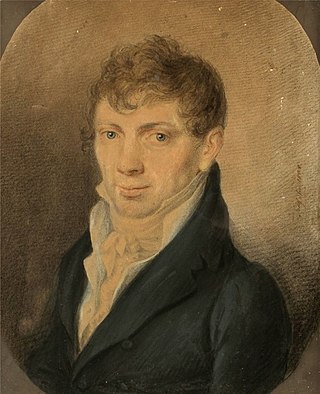
Theodosius Andreas Harnack was a Baltic German theologian.

Karl Wilhelm Julius Hugo Riemann was a German musicologist and composer who was among the founders of modern musicology. The leading European music scholar of his time, he was active and influential as both a music theorist and music historian. Many of his contributions are now termed as Riemannian theory, a variety of related ideas on many aspects of music theory.

Alexander Konstantin von Oettingen was a Baltic German Lutheran theologian and statistician.

Heinrich Friedrich Emil Lenz, usually cited as Emil Lenz or Heinrich Lenz in some countries, was a Russian physicist of Baltic German descent who is most noted for formulating Lenz's law in electrodynamics in 1834.
The original Tristan chord is heard in the opening phrase of Richard Wagner's opera Tristan und Isolde as part of the leitmotif relating to Tristan. It is made up of the notes F, B, D♯, and G♯:

Gustav Wilhelm Ludwig von Struve was a Baltic German astronomer, part of the famous Baltic German Struve family. In Russian, his name is sometimes given as Lyudvig Ottovich Struve or Lyudvig Ottonovich Struve.

Johann Heinrich von Mädler was a German astronomer.

Carl Gustav Axel Harnack was a Baltic German mathematician who contributed to potential theory. Harnack's inequality applied to harmonic functions. He also worked on the real algebraic geometry of plane curves, proving Harnack's curve theorem for real plane algebraic curves.

Gottfried Wilhelm Osann was a German chemist and physicist. He is known for his work on the chemistry of platinum metals.

The Tartu Observatory is the largest astronomical observatory in Estonia. On 1 January 2018, Tartu Observatory was joined again to the University of Tartu, and the observatory is now an institute of the university. It is located on the Tõravere hill, about 20 km south-west of Tartu in Nõo Parish, Tartu County. The old Tartu Observatory, located in Tartu city centre, is known internationally for its connection to Friedrich Georg Wilhelm von Struve and the Struve Geodetic Arc, of which it is the first reference point.

In musical tuning and harmony, the Tonnetz is a conceptual lattice diagram representing tonal space first described by Leonhard Euler in 1739. Various visual representations of the Tonnetz can be used to show traditional harmonic relationships in European classical music.

Heinrich von Wild or Heinrich Wild I (1833–1902) was a Swiss meteorologist and physicist who established a modern meteorological system throughout the Russian empire and developed meteorological instruments. He contributed significantly to international scientific collaboration in the fields of metrology and meteorology as a representative of Russia at the Paris diplomatic Conference which resulted in the Metre Convention of 1875, then as a member of the International Committee of Weights and Measures and as president of the International Meteorological Organization from 1879 to 1896.

Johann Christian Martin Bartels was a German mathematician. He was the tutor of Carl Friedrich Gauss in Brunswick and the educator of Lobachevsky at the University of Kazan.

Georg Philipp von Oettingen was a Baltic German physician and ophthalmologist. He was a brother of theologian Alexander von Oettingen (1827–1905), and physicist Arthur von Oettingen (1836–1920).

Hermann Guido von Samson-Himmelstjerna; name sometimes given as Guido Samson von Himmelstiern was a Baltic German physician and professor of Staatsarzneikunde.

Adolph Theodor Kupffer ForMemRS was a Baltic German chemist, and physicist. He founded the Depot of Standard Weights and Measures, and the main physical Observatory in Russia.

Riemannian theory, in general, refers to the musical theories of German theorist Hugo Riemann (1849–1919). His theoretical writings cover many topics, including musical logic, notation, harmony, melody, phraseology, the history of music theory, etc. More particularly, the term Riemannian theory often refers to his theory of harmony, characterized mainly by its dualism and by a concept of harmonic functions.

Karl August Senff was a Baltic German painter, engraver and teacher. He is best known for his etchings of famous German and Baltic German military figures in service to the Imperial Russian Army. He served as professor of drawing at the University of Dorpat from its reopening in 1802 until his death in 1838 where he trained some of Estonia's most celebrated artists.

Ernst Heinrich Bruns was a German mathematician and astronomer, who also contributed to the development of the field of theoretical geodesy.
Johann Sigismund Gottfried Huth was professor for mathematics and physics.


















